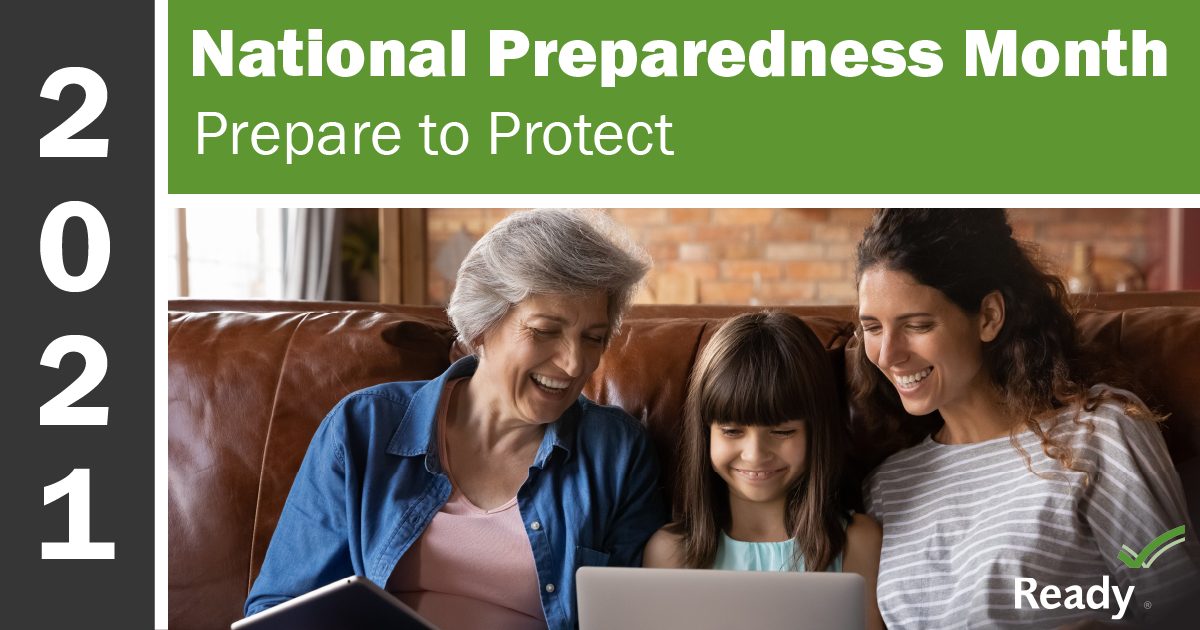You must have cookies enabled for the site to work properly.

Emergency Disaster Planning
Tuesday August 31, 2021
September Is National Preparedness Month
You may not be able to keep disasters from happening, but you can control how you prepare for them.
Make a Plan With Your Family
Make a plan now
If a disaster happens and your family is separated, it's crucial to know what kinds of calamities could hit your area. Know how you'll reconnect if you are separated. Create a familiar, easy-to-find family gathering spot.
• Talk about how you'll communicate in an emergency with your household or family.
• After making your plan, rehearse the critical steps with family members.
• Different evacuation plans will apply to houses, mobile homes, apartments and high-rise buildings. Make a plan for each location scenario.
• Include your entire family in disaster and emergency preparedness planning, so that they are prepared rather than afraid during the crises.
To begin your emergency plan, consider the answers to the following questions with your family and friends.
• How will I be notified of any emergency alerts or warnings?
• What is my plan for a safe, secure shelter after an evacuation?
• What route do I take for evacuating?
• What is my communication strategy for the family?
• Is it necessary for me to restock my emergency preparedness kit?
• Do I have PPE to protect my family from pandemics like COVID-19?
Customize your plans and supplies to your individual daily life demands and duties as you prepare your strategy. Make your own personal network to help you with specific areas where you require support. Discuss your needs and duties, as well as how members within your network can help one another with communication, child care, business, pets and other unique requirements such as first aid and medical care. When making your plan, include these considerations:
• Ages of household members
• Responsibilities for assisting others
• Frequented locations
• Dietary requirements
• Medical requirements, including prescriptions and supplies
• Disabilities or access and functional requirements, including devices and equipment
• Languages spoken
• Cultural and religious considerations
• School-aged children
• Pets or service animals
What do you need to include in your family emergency preparedness plan?
Phone Numbers
Post emergency numbers in a prominent location where they will not be overlooked. Include phone numbers for the police, fire department, poison control center, school, place of employment, child care and significant relatives. Because emergency responders will need to know where to find you, include your home address for quick reference.
An Emergency Contact
Assign an out-of-state relative as an emergency contact for your family. In the event of a natural disaster, they'll be the one you call or text to let them know where you are.
Escape Routes To Exit Your House
Plan the shortest and safest escape route from each room of your house. Make sure that everyone in your family is aware of the strategy for each room. They should practice the plan, so they know what to do if they need to flee quickly.
Emergency Meeting Locations
To be on the safe side, choose three locations. In the event of a fire, choose a location close to your home. Choose another location outside of your area (for example, the fire station or a relative's house). Have a location out-of-town should you need to evacuate.
Pet Plan
Include your pet family members in your emergency plan. Make sure you have any necessary pet carriers on hand, as well as plenty of food and water.
A Personal Care Package
This supply kit will make it easier for your family to leave the house fast and have the necessities you'll need while you're away. For more suggestions on what to include in your care package, see the following list...
• At least three days' worth of water for each family member
• Non-perishable food items like nuts, granola bars and canned foods
• Changes of clothes and shoes for each family member
• Sleeping bags, linens, blankets and pillows
• First aid kit
• Emergency items such as a battery-operated radio and flashlight with additional batteries, duct tape, plastic bags, local maps and a compass, aluminum foil, lighter/matches and a can opener
• Essential basic tools like pliers, wrench, an ax and utility knife
• Toilet paper, soap, toothbrushes, toothpaste, feminine hygiene products, spare eyeglasses and contact lens solution
• Money, credit cards and some personal checks
Get to know us before you need us by viewing our video below...
https://www.youtube.com/watch?v=xeEd9sjwFG8